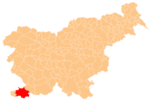Plavje
Plavje | |
|---|---|
Koper | |
| Area | |
| • Total | 2.99 km2 (1.15 sq mi) |
| Elevation | 84.7 m (277.9 ft) |
| Population (2002) | |
| • Total | 435 |
| [1] | |
Plavje (pronounced
It has a small border crossing with Italy, connecting it with the nearby village of Belpoggio in Noghere (Slovene: Beloglav), south of Trieste, which used to be a hamlet of Plavje (until 1954). Since Slovenia's accession to the European Union and the Schengen area, customs and immigration checks have been abolished at the Italian-Slovenian border.
Geography and climate
Plavje is located on a small slope overlooking the
History
During most of its history, Plavje was part of the municipality of
According to the last Austrian census of 1910/1911, the village had 771 inhabitants, of which 78.3% were
In 1907, a
Between 1947 and 1954, Plavje was part of Zone A of the Free Territory of Trieste. It remained under Anglo-American occupation until 1954, when it was ceded to the Socialist Federal Republic of Yugoslavia, thus cutting off its connections with the settlements of Muggia, Dolina and Trieste, which were left in Italy. Since then, it has been gravitating towards Koper. A local border crossing with Italy was opened northwest of village in 1955.
In 1991, it became part of independent Slovenia. During the Ten-Day War of 1991, some intensive fighting took place close to the village, at the international border crossing between Rabuiese, Italy and Spodnje Škofije, Slovenia.
Since 1991, it has mostly become a bedroom community of Koper, with most locals daily commuting to the town for work.
Economy
Plavje is an important center of local olive oil production. It also produces some quality wines, especially Refosco and Malvasia. Nevertheless, agriculture is a part-time activity because most of the people commute to Koper for work.
Culture and traditions
The great majority of the population of the village are Slovenes, and they speak the Rižana subdialect of the Istrian dialect.
The local church is dedicated to Saint Lucy and is now a chapel of ease of the Parish of Škofije, established in 1960.[4]


